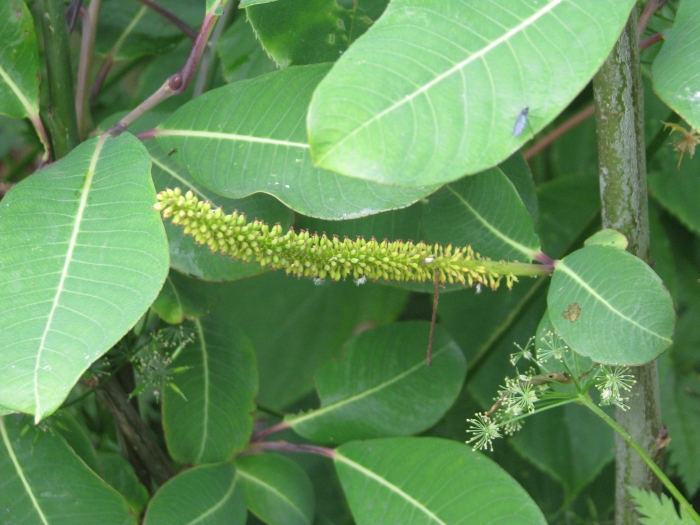Magnolia Leaf Willow
(Salix magnifica)
Magnolia Leaf Willow (Salix magnifica)
/
/

peganum
CC BY-SA 2.0
Image By:
peganum
Recorded By:
Copyright:
CC BY-SA 2.0
Copyright Notice:
Photo by: peganum | License Type: CC BY-SA 2.0 | License URL: https://creativecommons.org/licenses/by-sa/2.0/ | Uploader: peganum | Publisher: Flickr |


















Estimated Native Range
Summary
Salix magnifica, commonly known as Magnolia Leaf Willow, is a deciduous shrub native to the forest margins and stream banks of South-Central China. It can grow up to 6 meters (20 feet) tall and is notable for its large, magnolia-like leaves which are 10–25 cm long and 7–12 cm broad, with an entire margin. The leaves are green above and glaucous below, with distinctive red veins and petioles, adding to the plant’s ornamental value. The flowers, produced in catkins, emerge in late spring after the new leaves appear. Salix magnifica is dioecious, meaning male and female flowers are found on separate plants. The male catkins are about 10 cm long, while the female catkins are initially the same size but expand to 25 cm long as the seeds mature.
The Magnolia Leaf Willow is valued for its unique foliage and is used in gardens and parks for its visual interest, particularly in moist areas such as near ponds or streams. It requires full sun to part shade and thrives with high amounts of water, preferring soils with medium drainage. While it is not commonly found in cultivation, its striking appearance makes it a desirable choice for collectors and those looking to create a focal point in their garden. Gardeners should be aware that, like many willows, it may be susceptible to pests such as aphids and diseases like willow scab and canker.CC BY-SA 4.0
The Magnolia Leaf Willow is valued for its unique foliage and is used in gardens and parks for its visual interest, particularly in moist areas such as near ponds or streams. It requires full sun to part shade and thrives with high amounts of water, preferring soils with medium drainage. While it is not commonly found in cultivation, its striking appearance makes it a desirable choice for collectors and those looking to create a focal point in their garden. Gardeners should be aware that, like many willows, it may be susceptible to pests such as aphids and diseases like willow scab and canker.CC BY-SA 4.0
Plant Description
- Plant Type: Shrub
- Height: 10-20 feet
- Width: 5-10 feet
- Growth Rate: Moderate
- Flower Color: N/A
- Flowering Season: Spring
- Leaf Retention: Deciduous
Growth Requirements
- Sun: Full Sun, Part Shade
- Water: High
- Drainage: Medium
Common Uses
Bee Garden, Bird Garden, Butterfly Garden, Deer Resistant, Low Maintenance
Natural Habitat
Native to the forest margins and stream banks of South-Central China
Other Names
Common Names: Praktvide
Scientific Names: , Salix magnifica, Salix magnifica var. magnifica, Salix magnifica var. microphylla,
GBIF Accepted Name: Salix magnifica Hemsl.